How to optimize for AI Overviews: 7 best practices to follow
According to Google, you should be able to qualify for inclusion in AI Overviews just by following its Search Essential guidance. However, some specific tactics could help your website get featured.
We analyzed opinions around the web, added our observations from the SE Ranking Blog, and compiled a list of key strategies to help you get the most out of AI Overviews and be visible in AI search.
-
Run experiments, monitor AI Overviews, and analyze content patterns. This provides insights into what works best and how to improve your tests and strategy.
-
Apply traditional SEO strategies to get your pages to rank in the top 10 results, including technical, on-page, and off-page optimizations. AI Overviews often cite these pages.
-
Write comprehensive content and structure it properly. Create content clusters, provide detailed answers, present multiple perspectives, include supporting data, and make content scannable, using lists, proper headings, and tagging.
-
Regularly update content with new data, statistics, and insights. This signals relevance and freshness and can improve your chances of being cited in AI Overviews.
-
Fact-check your content, showcase author and brand expertise, and get mentions from other reputable resources. Authoritative content will help you build credibility and EEAT.
-
Optimize for SERP features. Pages that appear in Featured Snippets, People Also Ask, and other Google SERP features have a higher likelihood of being included in AI Overviews. Keep your content SERP-friendly.
What AI Overviews are in Google search
AI Overviews (AIO) are an AI search feature that appears at the top of the Google SERP in the form of AI-generated answers. Google’s large language models analyze information from relevant sources to generate responses directly on the search engine results page.
Google also includes a list of resources for generating answers. Users can check them through website links.
However, these AI answers in combination with other SERP features increase the chances of zero-click searches because users can find answers without going to specific websites.
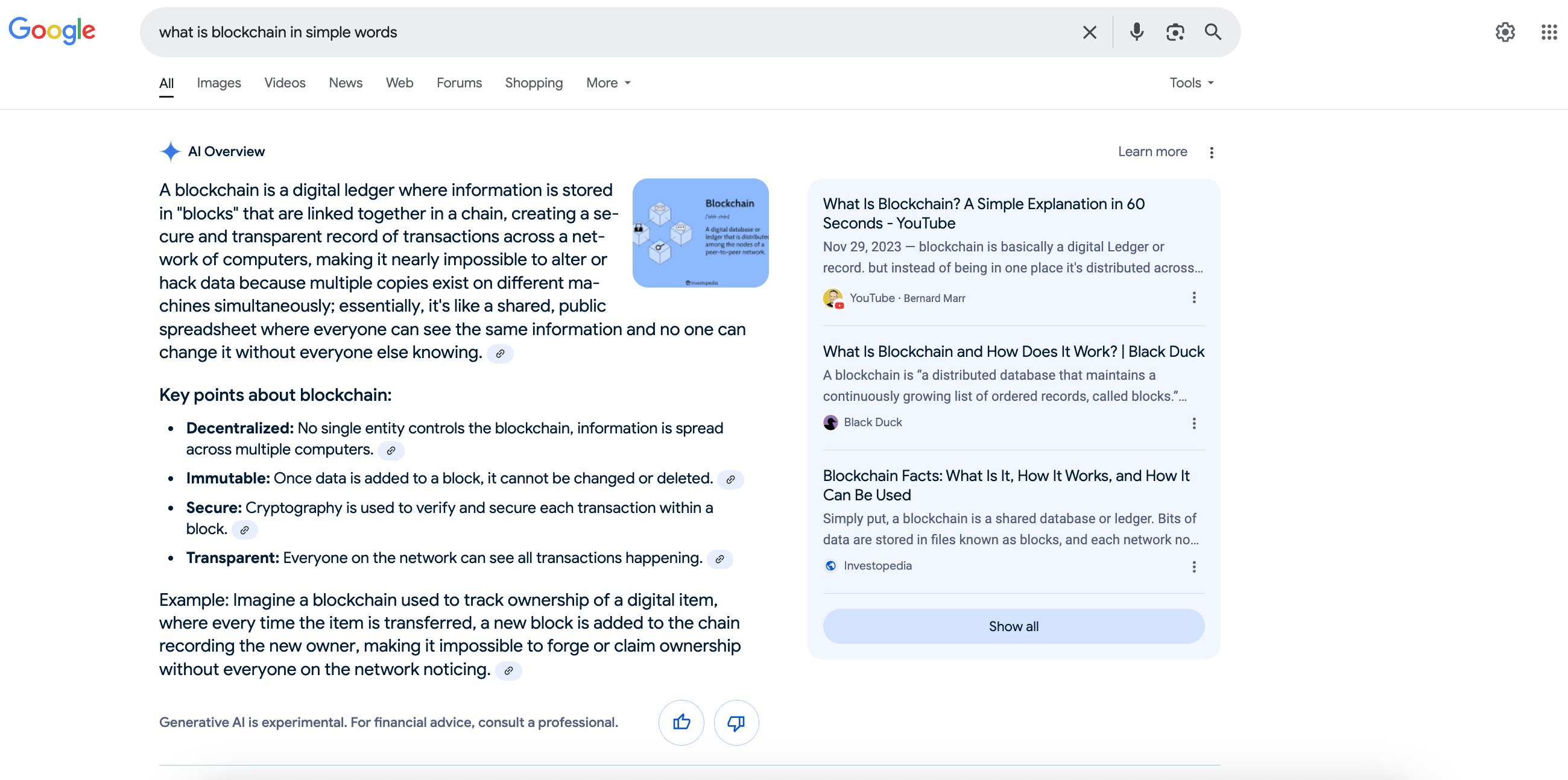
How to rank in Google’s AI Overviews: Generative engine optimization principles
The strategies below can help you get featured in AIOs as a source from which to generate traffic to your website. This means linked mentions directly in the AI snippets. But even branded non-linked mentions are beneficial. You might not get traffic directly from them, but your brand will become more visible and trustworthy.
Run experiments and track AI search content preferences
AI Overviews are still a relatively new SERP feature, with evolving selection criteria and behavior patterns. Like any new search element, achieving success around it means continuously monitoring and experimenting to understand what works and what doesn’t.
Here are the following tactics that work right now:
- Adding bulleted lists or labeled lists
- Breaking up your content into smaller subsections
- Writing short, reader-friendly sentences
- Answering the main question right away
For example, we got interesting results from our experiments with AI-generated content: four AI-assisted articles on the SE Ranking blog were featured as sources in AI Overviews. While we agree that fully automated content creation isn’t recommended, this experiment suggests that certain AI-written patterns can increase your chances of being referenced in AIOs.
SE Ranking’s AIO Research tool shows you all AI Overviews (AIOs) that mention your website: brand name in the text or your link in sources. You can track how your AIO presence changes over time, including your AIO traffic and average positions.
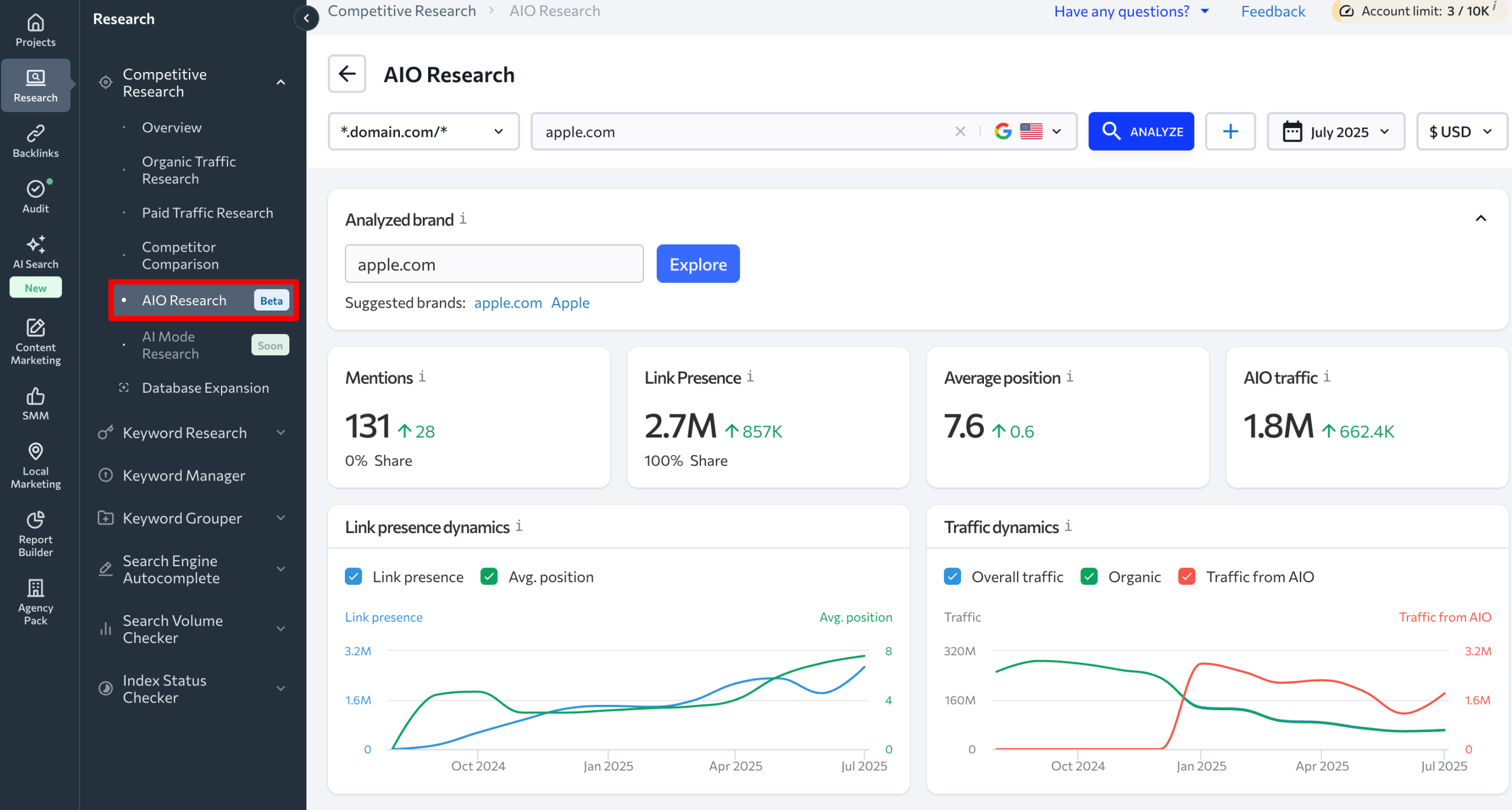
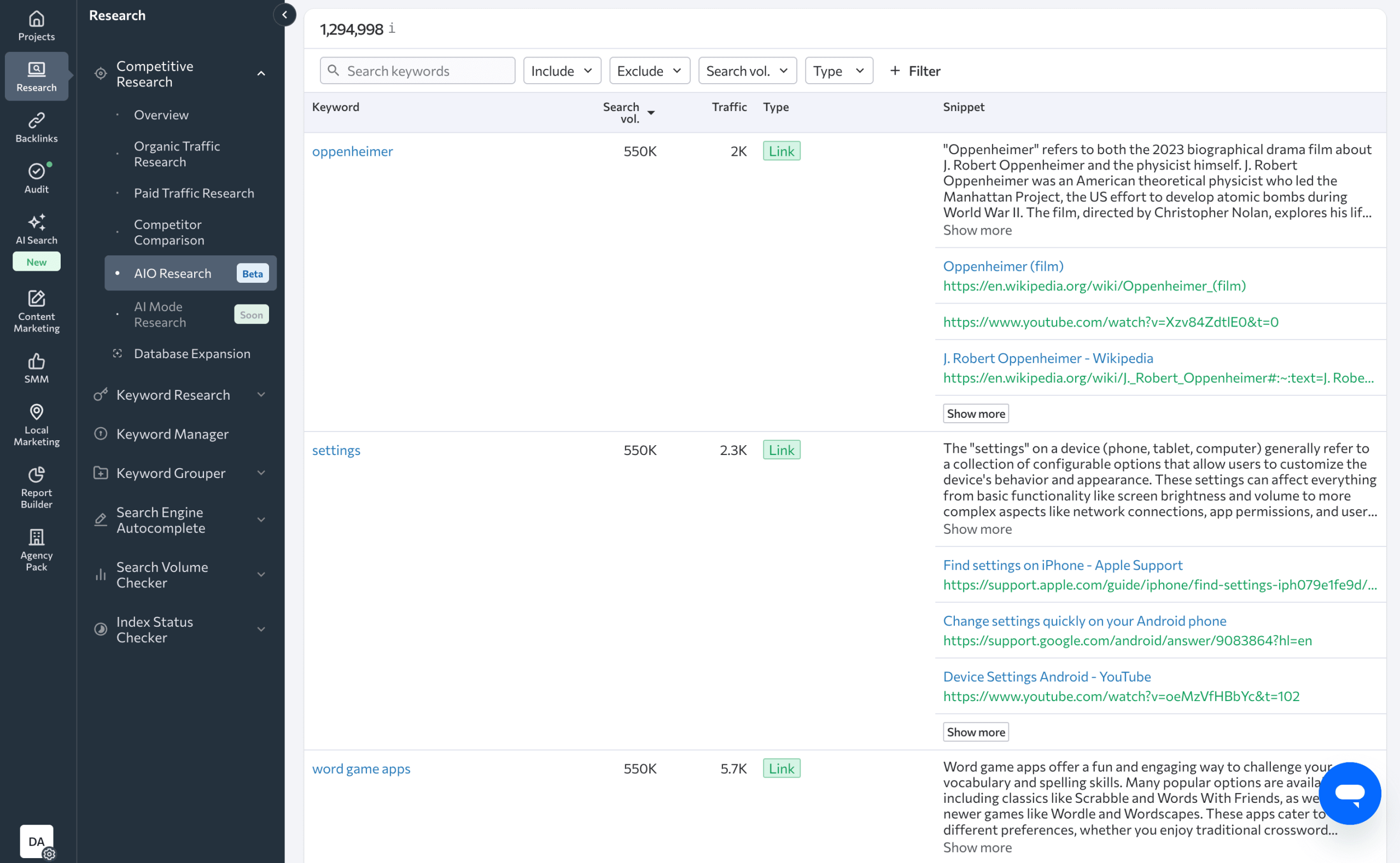
All snippets, including the full text and list of sources, are available in the table. You can also see exactly which parts of your content are being quoted. Just click on your link in the sources list to view the specific text used in the AI Overview.
This makes it easier to spot patterns and understand what type of content Google highlights — a great way to figure out what’s working and how to optimize for even more AI visibility.
Looking for ways to appear in even more AIOs? With SE Ranking’s Competitive Research, you can find your keywords that trigger AIOs but don’t mention your site. Just filter by the AI Overview SERP feature and choose Not linking to domain. That way, you get a list of keywords you already rank for—but where you’re missing from the AI Overview—and can start working your way in.
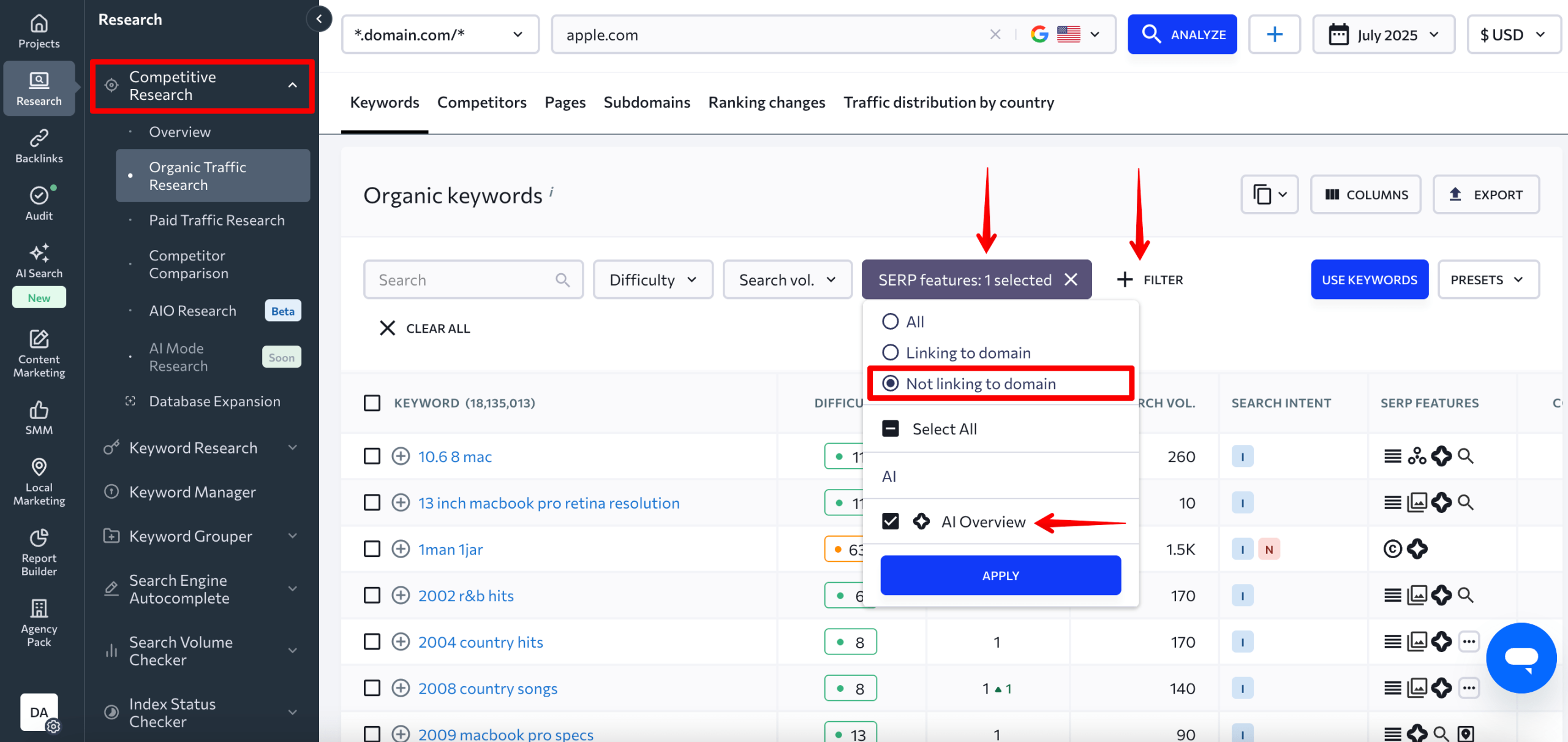
Learn how to automate your SEO workflow — from SEO research and content creation to technical optimization — in our AI for SEO guide.
Perform SEO regularly
We highly recommend doing SEO on a regular basis to rank in the top 10. Our latest AI Overviews research shows that AI-generated answers link to at least one domain ranking in the organic top 10 in 92.36% of cases. 63.19% of the time, AIOs pull information from pages that rank in the organic top 10.
Our blog performance data shows similar trends. For 70% of keywords where our blog pages rank in AI Overviews, they also rank in the top 10 organic search. 40% of them rank in the top 5.

Create comprehensive content based on keyword research and clustering
Google’s goal with AI Overviews is to give users complete, detailed answers. Make sure your content provides deep context and relevance. This increases its chances of being selected as a source in AIOs. Here’s how:
Create content clusters
Create interconnected groups of content around main topics. For example, if you’re targeting “canonical tags guide,” create articles about common canonical tag issues, canonicals vs 301 redirects, and canonical vs hreflang.
This is what we did on the SE Ranking blog. This approach positions your website as a well-rounded resource which the AI system may favor. It’s also recommended to cover related subtopics from within the same article, but be careful. You don’t want to dilute the search intent behind the user’s query.
Tools like Keyword Research make it easy to collect relevant keywords. According to our data, longer search queries with 4+ words trigger AIOs in 60.85% of cases. These queries are generally informational and require content creators to write specific answers. AIOs can then transform these answers into concise overviews. To get featured in AIOs, include top-of-the-funnel keywords in your search strategy.
After that, use Keyword Grouper to cluster your keywords into suitable topic groups.
Here’s how to use both:
Present different points of view
AI Overviews favor well-rounded content that presents various perspectives. Present the subject from multiple angles. Discuss widely accepted viewpoints and add depth with unique or individual opinions.
Include supporting data
Make your content more credible by backing up claims with recent statistics, research findings, and expert quotes.
Structure your content properly and make it scannable
Content structured well is easier for users and AI systems to process and understand. Here is what to do when optimizing texts:
- Break information into digestible chunks: Two to three sentences per paragraph is ideal and improves readability.
- Use lists to present information or related points: This format is often directly used in AIOs.
- Implement proper H1-H6 tags: This creates a logical content flow and helps AI systems understand content relationships.
- Include relevant images, videos, and infographics: This supports text content and provides additional context.
- Add a <strong> tag: This highlights key elements.
Also, structure your content to deliver primary answers up front. Place direct answers to the article’s primary question in the first few paragraphs of your content. This approach helps AI systems immediately identify essential information and then embed it into AI-generated responses in search.
We also noticed that definition sections rank well in AI Overviews. On our blog, we use an <h2> with the question “What is” and provide a clear answer in 2-3 short paragraphs. Here’s an example:
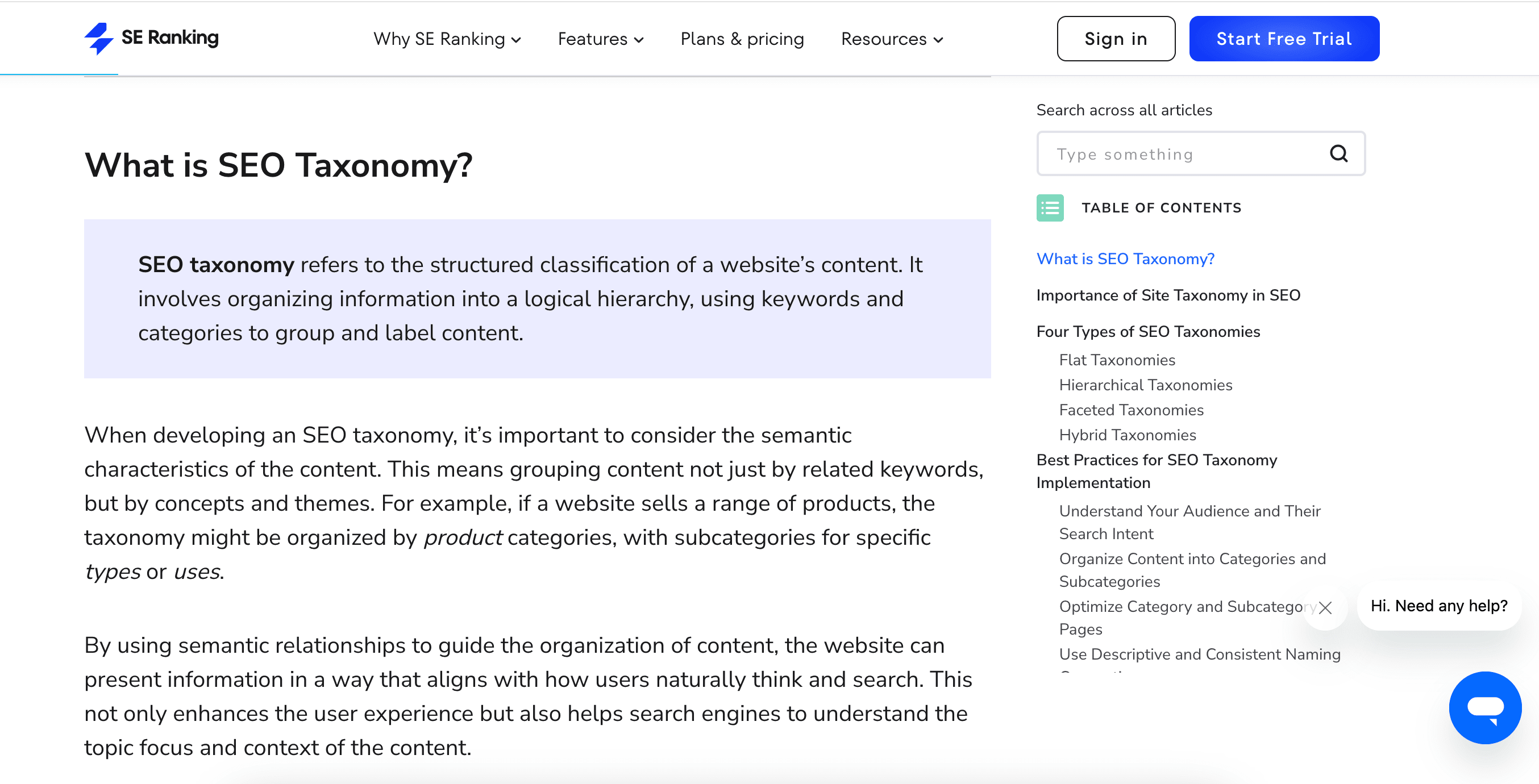
This AIO references the information from this section of our article. It also links directly to our blog. As of January 2025, the average AIO position on this post is three.
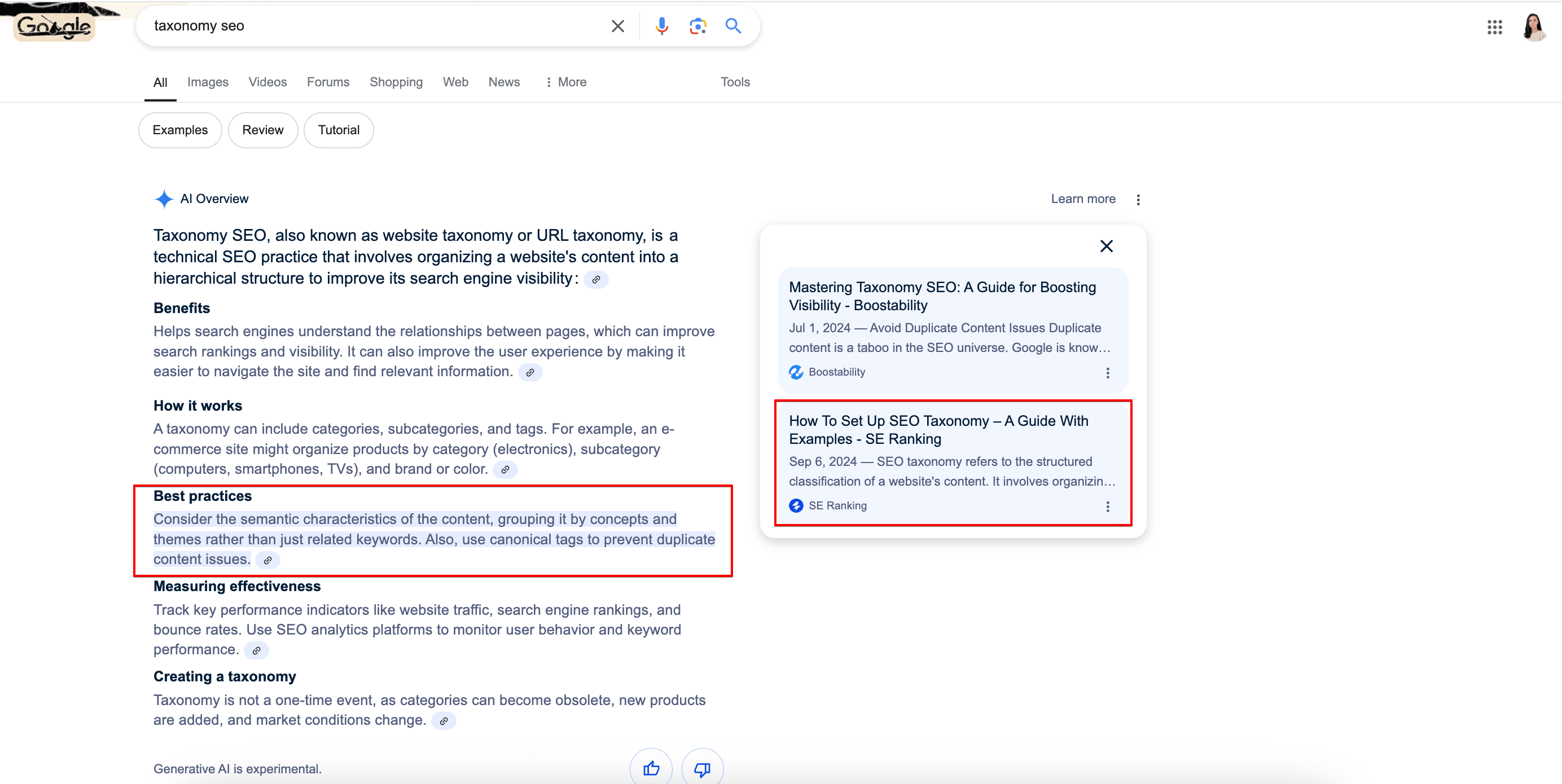
Include summary (or takeaway) sections to provide quick overviews of the main points. These summaries can be placed directly onto Google search results as featured snippets or into an AI Overview with a link to your article.
Here’s an example of an AI Overview linking to an article on the SE Ranking blog about canonicals vs. redirects on the SE Ranking blog. It embeds a key information from our Key Takeaways section.
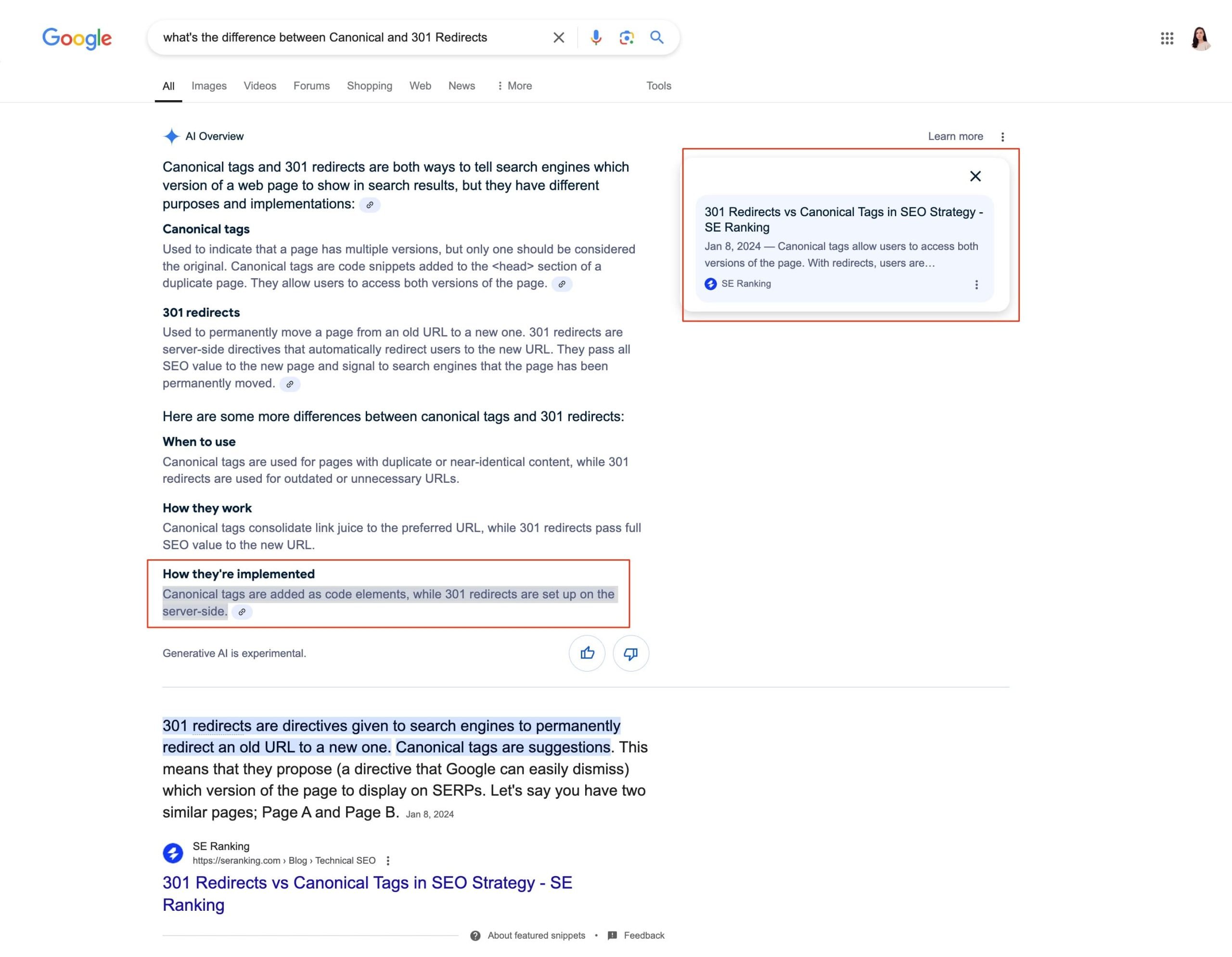
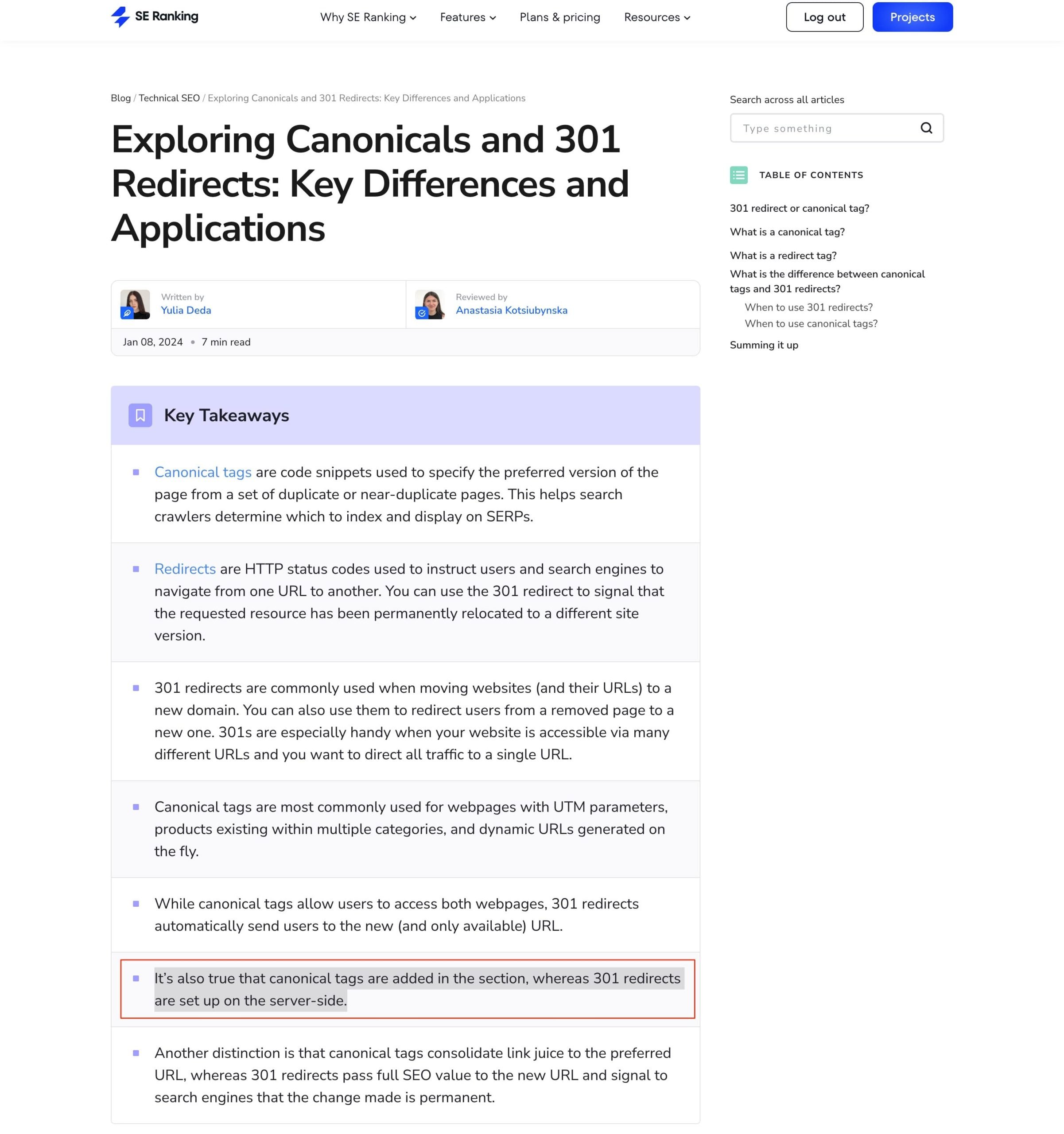
Keep your content fresh
While AI Overviews still pull from many older pages, keeping your content up to date with a recent publish date can also positively impact your CTR.
Our media presence research shows that AI Overviews tend to favor newer content, though not always the most recent. The majority of citations come from blog posts published in 2025 (28.76%) and 2024 (26.85%), which together account for over half of all sources. But an additional 11.83% of citations are from 2023.
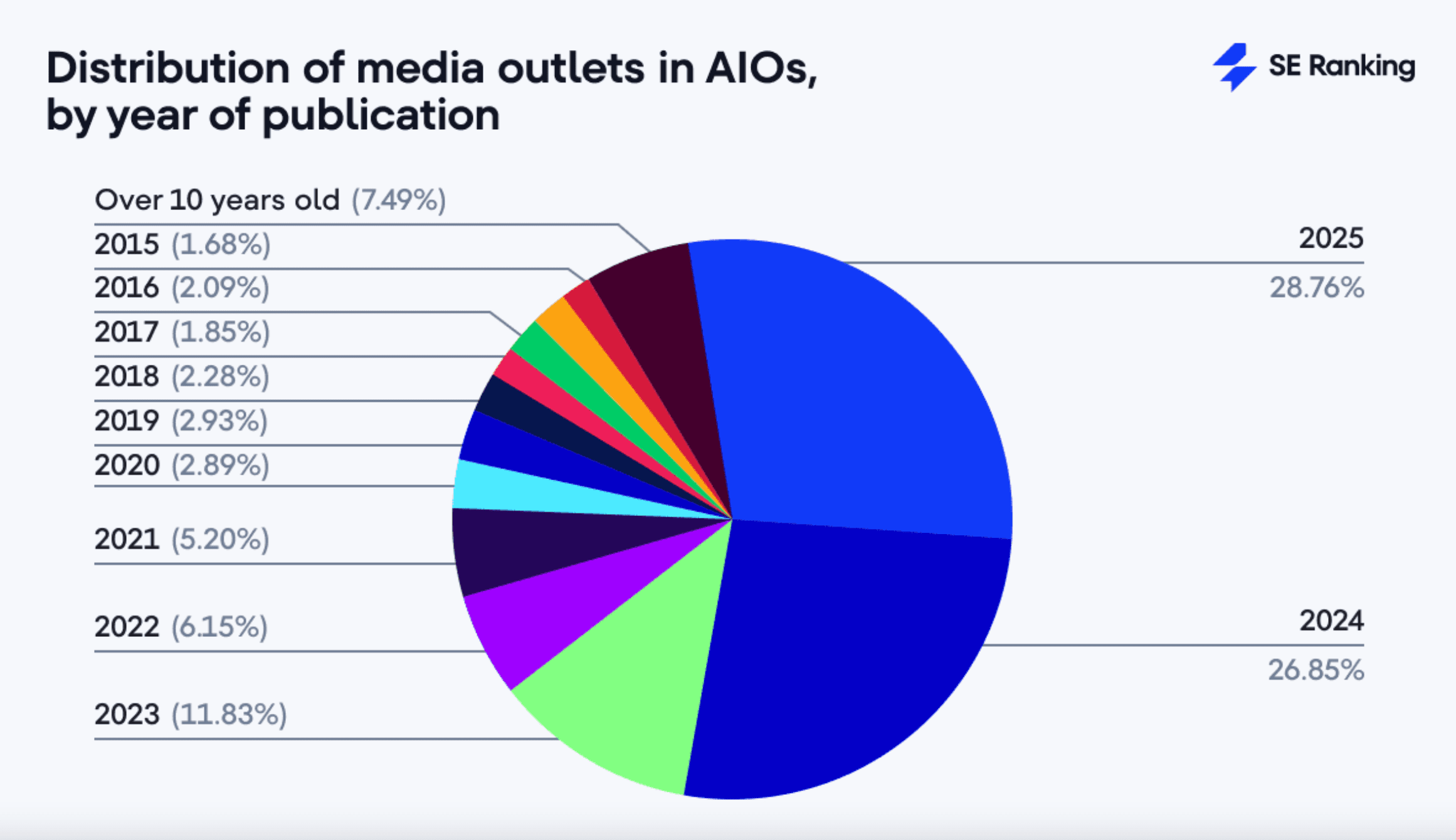
Only 12.32% of cited sources were published within 30 days of parsing (as of April 28, 2025). This suggests that AIOs aim to balance freshness with reliability, often favoring content that has been live long enough to establish trust. So, while Google’s AI Overviews don’t automatically pull the newest articles, keeping your content up to date still significantly boosts your chances of being cited.
Here’s what we recommend:
- Set up a regular schedule to review and refresh older content.
- Regularly update stats, data, and examples
- Add unique insights or previously untapped perspectives.
Prioritize your EEAT and online reputation
AI Overviews often feature links from sources that Google considers authoritative. That’s why improving your EEAT and reputation is essential. Here are a few key areas to focus on:
- Fact-check content: Ensure your content is accurate, well-researched, and offers valuable insights. Consider mentioning who reviewed and verified your content, along with the author.
- Demonstrate author expertise: Highlight the authors’ qualifications and experience with the subject. Include author profiles on your website with short bios and links to their social media. To build trust, switch to real author names instead of “Written by [Company Name] team” or similar attributions.
- Do digital PR: Regularly pursue guest posts, partnerships, and link-building opportunities to gain mentions from reputable sites. This builds your reputation online.
- Showcase your brand expertise: Build a strong online presence through thought leadership and active industry engagement. This means maintaining consistent social media presence, which many teams manage through Planable or similar platforms, alongside pursuing media interviews, conference speaking opportunities, and research contributions.
Don’t underestimate technical SEO
Proper technical search engine optimization helps Google’s AI systems effectively crawl, understand, and extract information from your content. Structured data plays a key role in ensuring AI can interpret your content accurately. Implement relevant schema markups, such as Article, FAQ, HowTo, and Reviews, to provide clear and structured information that AI systems can easily parse.
Other important elements include image compression, browser caching, HTTPS security, and mobile optimization. You can check for any related errors with Website Audit, which detects 115+ technical issues, provides fix tips, and lets you set up scheduled audits to identify and correct errors on time.
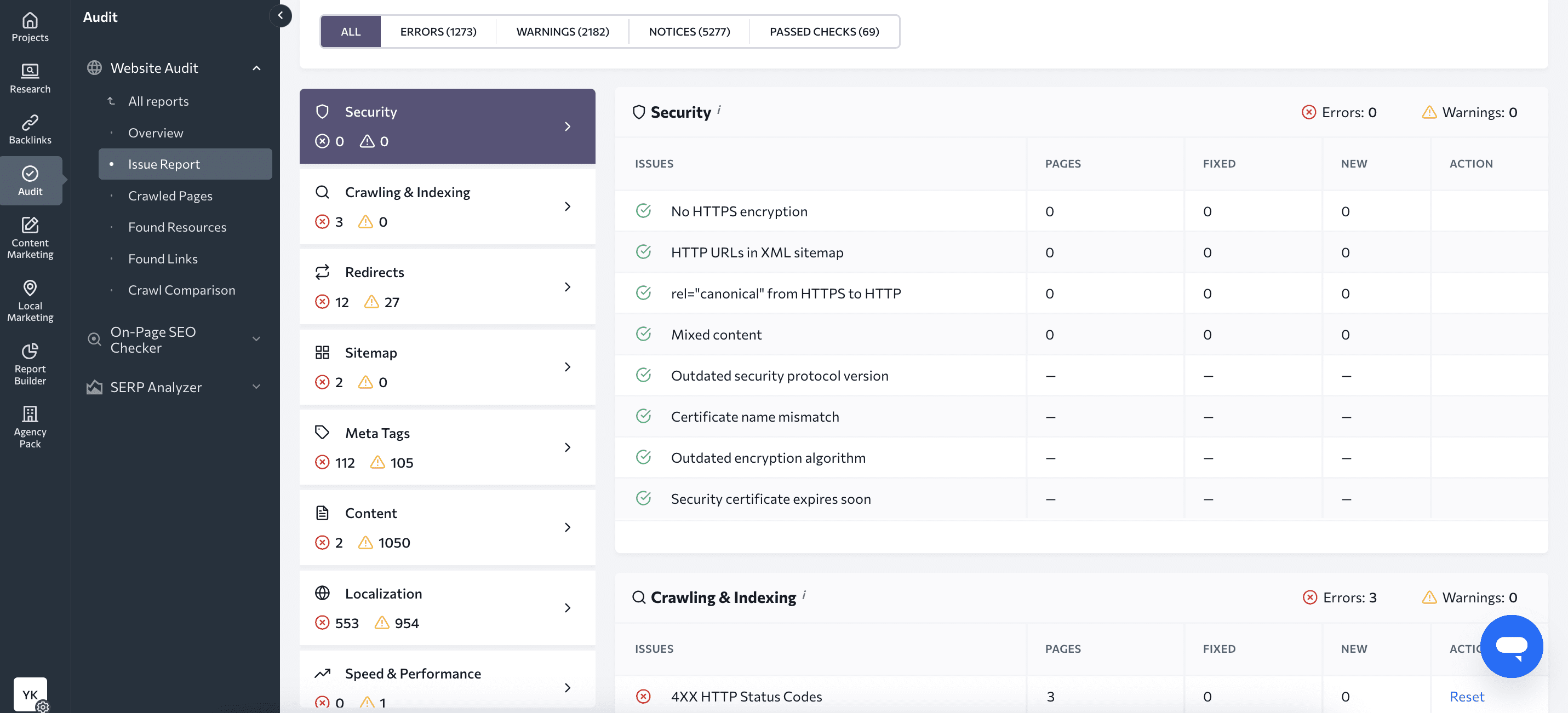
Optimize for Featured snippets, People Also Ask, and other Google SERP features
AIOs tend to appear alongside other SERP features in organic search results. For example, our research shows that AIOs appeared with at least one SERP feature 99.25% of the time. Only 0.75% appeared on their own.
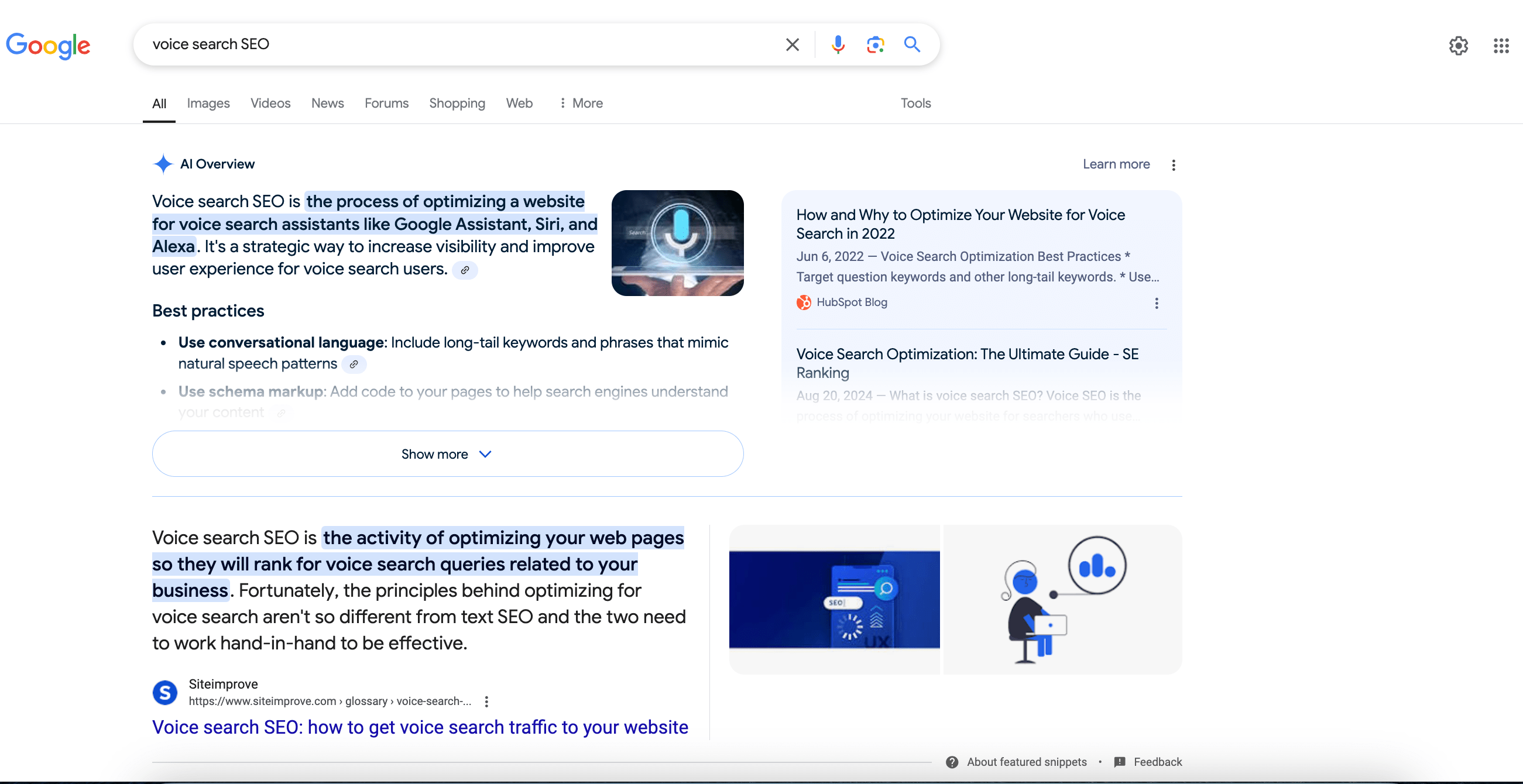
Their most common companions were:
- People Also Ask (98.54%)
- Videos (45.17%)
- Reviews (25.30%)
- Images (11.67%)
- Featured snippets (8.63%)
This makes sense, as AI Overviews often favor direct answers to related questions, aligning with the PAA feature.
Want to stand out even more in the SERPs? Discover how Google sitelinks can boost your visibility—read our guide.
This suggests that if your content is featured in Google SERP features, it is likely to also appear in an AIO. And even if your link doesn’t appear in an AIO, your page can still benefit from being mentioned prominently on the SERP.
Here are some recommendations to follow:
- Format your content to match common snippets and feature types.
- Provide concise definitions or explanations.
- Use bullet points or numbered lists when making step-by-step guides.
- Present data in tables.
- Incorporate question-based headings (e.g., “What is…?” or “How to…?”) followed by succinct answers.
If your business has a physical location, try Google Maps ads to get more local visibility.
Conclusion
While AI Overviews often distract users and traffic from traditional web listings, they can also help you improve your search engine visibility.
Optimizing your content strategically increases your chances of securing a spot within AIOs at the top of the SERP. A linked mention can drive traffic to your website and reinforce brand credibility, while an unlinked mention still increases brand awareness and authority.
Either way, don’t overlook how useful it can be to appear in AI Overviews. The strategies we described above can help you succeed in both scenarios, so make sure to add them to your strategy.

